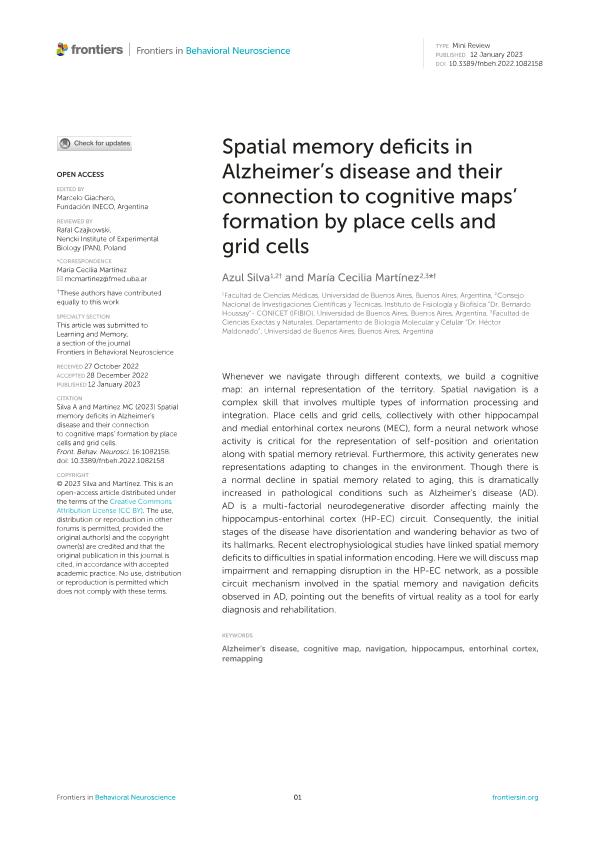Mostrar el registro sencillo del ítem
dc.contributor.author
Silva, Azul

dc.contributor.author
Martínez, María Cecilia

dc.date.available
2024-02-02T14:44:40Z
dc.date.issued
2023-01
dc.identifier.citation
Silva, Azul; Martínez, María Cecilia; Spatial memory deficits in Alzheimer’s disease and their connection to cognitive maps’ formation by place cells and grid cells; Frontiers Media; Frontiers in Behavioral Neuroscience; 16; 1-2023; 1-8
dc.identifier.issn
1662-5153
dc.identifier.uri
http://hdl.handle.net/11336/225612
dc.description.abstract
Whenever we navigate through different contexts, we build a cognitive map: an internal representation of the territory. Spatial navigation is a complex skill that involves multiple types of information processing and integration. Place cells and grid cells, collectively with other hippocampal and medial entorhinal cortex neurons (MEC), form a neural network whose activity is critical for the representation of self-position and orientation along with spatial memory retrieval. Furthermore, this activity generates new representations adapting to changes in the environment. Though there is a normal decline in spatial memory related to aging, this is dramatically increased in pathological conditions such as Alzheimer’s disease (AD). AD is a multi-factorial neurodegenerative disorder affecting mainly the hippocampus-entorhinal cortex (HP-EC) circuit. Consequently, the initial stages of the disease have disorientation and wandering behavior as two of its hallmarks. Recent electrophysiological studies have linked spatial memory deficits to difficulties in spatial information encoding. Here we will discuss map impairment and remapping disruption in the HP-EC network, as a possible circuit mechanism involved in the spatial memory and navigation deficits observed in AD, pointing out the benefits of virtual reality as a tool for early diagnosis and rehabilitation.
dc.format
application/pdf
dc.language.iso
eng
dc.publisher
Frontiers Media

dc.rights
info:eu-repo/semantics/openAccess
dc.rights.uri
https://creativecommons.org/licenses/by-nc-sa/2.5/ar/
dc.subject
ALZHEIMER’S DISEASE
dc.subject
COGNITIVE MAP
dc.subject
ENTORHINAL CORTEX
dc.subject
HIPPOCAMPUS
dc.subject
NAVIGATION
dc.subject
REMAPPING
dc.subject.classification
Neurociencias

dc.subject.classification
Medicina Básica

dc.subject.classification
CIENCIAS MÉDICAS Y DE LA SALUD

dc.title
Spatial memory deficits in Alzheimer’s disease and their connection to cognitive maps’ formation by place cells and grid cells
dc.type
info:eu-repo/semantics/article
dc.type
info:ar-repo/semantics/artículo
dc.type
info:eu-repo/semantics/publishedVersion
dc.date.updated
2024-02-02T11:16:28Z
dc.journal.volume
16
dc.journal.pagination
1-8
dc.journal.pais
Suiza

dc.journal.ciudad
Laussane
dc.description.fil
Fil: Silva, Azul. Consejo Nacional de Investigaciones Científicas y Técnicas. Oficina de Coordinación Administrativa Houssay. Instituto de Fisiología y Biofísica Bernardo Houssay. Universidad de Buenos Aires. Facultad de Medicina. Instituto de Fisiología y Biofísica Bernardo Houssay; Argentina
dc.description.fil
Fil: Martínez, María Cecilia. Universidad de Buenos Aires. Facultad de Ciencias Exactas y Naturales. Departamento de Fisiología, Biología Molecular y Celular; Argentina. Consejo Nacional de Investigaciones Científicas y Técnicas. Oficina de Coordinación Administrativa Houssay. Instituto de Fisiología y Biofísica Bernardo Houssay. Universidad de Buenos Aires. Facultad de Medicina. Instituto de Fisiología y Biofísica Bernardo Houssay; Argentina
dc.journal.title
Frontiers in Behavioral Neuroscience
dc.relation.alternativeid
info:eu-repo/semantics/altIdentifier/url/https://www.frontiersin.org/articles/10.3389/fnbeh.2022.1082158/full
dc.relation.alternativeid
info:eu-repo/semantics/altIdentifier/doi/http://dx.doi.org/10.3389/fnbeh.2022.1082158
Archivos asociados
